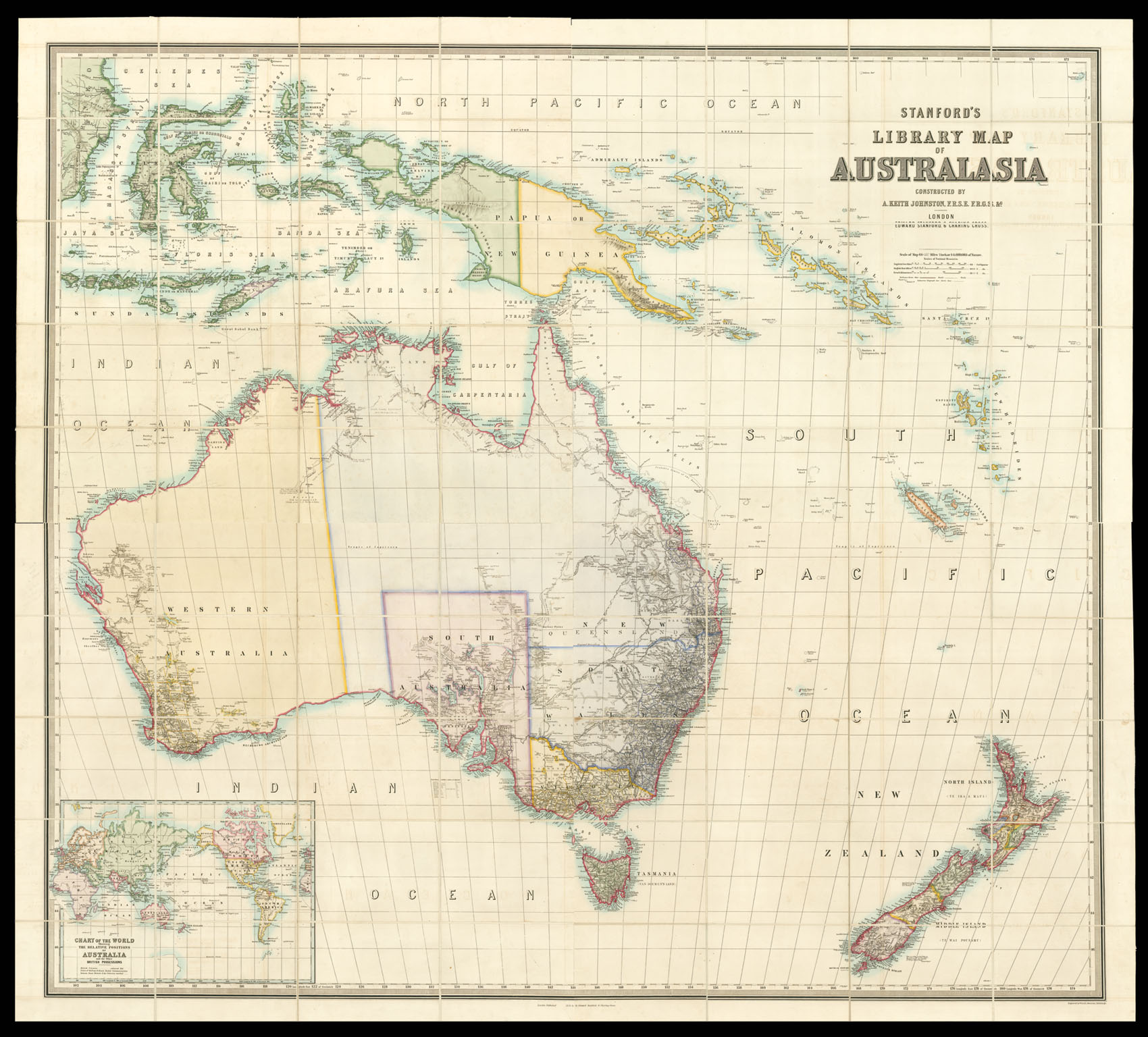
Stanford's Library Map of Australasia constructed by A. Kieth Johnston F.R.S.E., F.R.G.S. &c.
- Author: JOHNSTON, A. Keith
- Publication place: London
- Publisher: Edward Stanford, 6 Charing Cross
- Publication date: 1859.
- Physical description: Engraved map dissected and mounted on linen, in four sections, inset map of the world, showing the relative positions of Australia and the other British possessions, housed in blue cloth slipcase, lettered in gilt to spine.
- Dimensions: 1550 by 1740mm (61 by 68.5 inches).
- Inventory reference: 2139
Notes
Stanford’s monumental map of Australasia. The map was glowingly reviewed by the Australian Mail in 1859:
“A bad map exhausts the patience both of the student and the man of business. It is dear at any price, however low. On the other hand, it is a real pleasure to study a good, bold, well-executed map, brought up to the latest date. Mr. Stanford’s new Library Map of Australasia fulfills every requirement. It is quite a work of art. Engraved in the finest style on copper plates, upon the large scale of 64 miles to an inch, which brings the entire size of the Map to 65 inches by 58, it is worthy of a place in any nobleman’s library. It forms the second of a series of large library Maps, delineating the great terrestrial divisions of the globe. The Map of Europe was the first; the Map of Australasia is the second; Asia, Africa, North America, and South America will follow. Instead of giving Australasia as an appendage to the Asiatic continent, the publisher recognises the great and growing importance of the English colonies, by giving them a special map. He is fully justified in claiming admiration of the work. The “insertion of several new and important surveys and discoveries, never before published together; the introduction of new administrative boundaries; the boldness and perspicacity as well as the precision of the delineation and names; the distinctive colouring; and the comprehensive scope of the Map,” form only a few of its meritorious features. The manner in which Mr. A.K. Johnston has performed his task is deserving of the highest praise. To prove that the work has been brought down to the latest date, it may be mentioned that the lately-formed province of Hawke Bay, in New Zealand, is distinctively marked; not so, however, Queensland, to the north of New South Wales, the boundaries being yet undetermined. The remarkable additions made to Australasian geography by exploring parties and new surveys are fully given. The explorations of Mr. McDougal Stuart, far beyond the Gawler Ranges, in South Australia; those of Mr. Herschel Babbage and Mr. Augustus Gregory, the latter of whom made the first overland journey from Moreton Bay to Adelaide; the researches of Captain Sturt from the South and of Mr. Kennedy from the NorthEast, together with those of Mr. F. T. Gregory in Western Australia; and the investigations in Northern Australia by eight or nine different explorers, – all receive due notice. It is justly remarked that “the vast extent of unexplored country forming the northern and central parts of Australia must derive fresh interest from these successes, as they prove that the blank spaces on the Map, instead of being wholly desert, may include an abundance of valuable territory, and still hold out rich rewards to colonial enterprise.” The last surveys in New Zealand are likewise embodied. Embraced within the extended scope of the Map are – in addition to Tasmania and New Zealand – Norfolk Island, “once a pest-house of crime, but now a thriving settlement,” the French settlement of New Caledonia, New Guinea, and a large portion of the Asiatic Archipelago.”(Australian Mail, 15/9/1859)
Edward Stanford (1827-1904), began his career in maps at the stationers Trelawney and Saunders, where he was made partner in 1852 at the age of 25. A year later the partnership was dissolved with Stanford taking over the remains of the business. Edward would turn the business into one of the most important cartographic firms of the nineteenth century, its reputation based upon such maps as his Library series. The firm is still in existence today operating from his purpose built shop at 12-14 Long Acre in London.
Bibliography
- NLS Area I.3(112) Maps.1.33.11
- Tooley, 1187.
 Rare Maps
Rare Maps  Rare Atlases
Rare Atlases  Rare Books
Rare Books  Rare Prints
Rare Prints  Globes and Planetaria
Globes and Planetaria 










